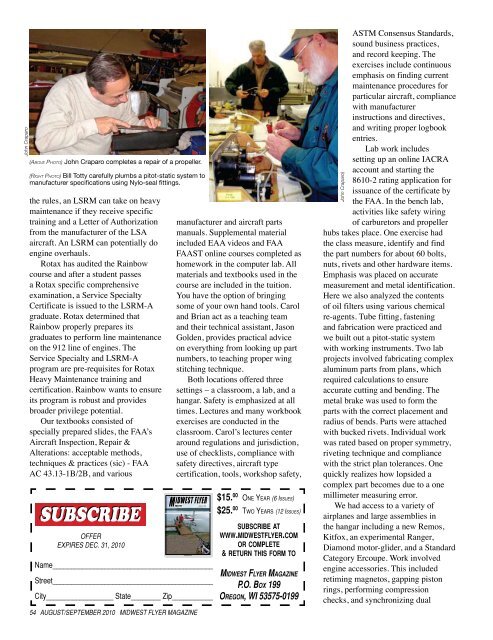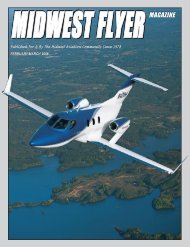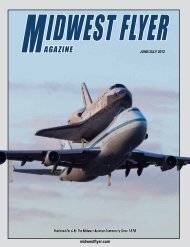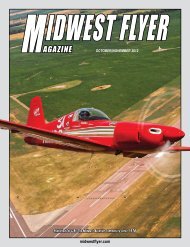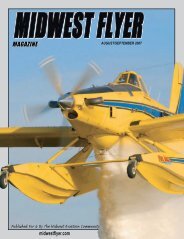AGAZINE - Midwest Flyer
AGAZINE - Midwest Flyer
AGAZINE - Midwest Flyer
You also want an ePaper? Increase the reach of your titles
YUMPU automatically turns print PDFs into web optimized ePapers that Google loves.
midwestflyer.com<br />
John Craparo<br />
(Ab o v e Ph o t o) John Craparo completes a repair of a propeller.<br />
(Ri g ht Ph o t o) Bill Totty carefully plumbs a pitot-static system to<br />
manufacturer specifications using Nylo-seal fittings.<br />
the rules, an LSRM can take on heavy<br />
maintenance if they receive specific<br />
training and a Letter of Authorization<br />
from the manufacturer of the LSA<br />
aircraft. An LSRM can potentially do<br />
engine overhauls.<br />
Rotax has audited the Rainbow<br />
course and after a student passes<br />
a Rotax specific comprehensive<br />
examination, a Service Specialty<br />
Certificate is issued to the LSRM-A<br />
graduate. Rotax determined that<br />
Rainbow properly prepares its<br />
graduates to perform line maintenance<br />
on the 912 line of engines. The<br />
Service Specialty and LSRM-A<br />
program are pre-requisites for Rotax<br />
Heavy Maintenance training and<br />
certification. Rainbow wants to ensure<br />
its program is robust and provides<br />
broader privilege potential.<br />
Our textbooks consisted of<br />
specially prepared slides, the FAA’s<br />
Aircraft Inspection, Repair &<br />
Alterations: acceptable methods,<br />
techniques & practices (sic) - FAA<br />
AC 43.13-1B/2B, and various<br />
SUBSCRIBE<br />
OFFER<br />
EXPIRES DEC. 31, 2010<br />
54 AUGUST/SEPTEMBER 2010 MIDWEST FLYER M<strong>AGAZINE</strong><br />
manufacturer and aircraft parts<br />
manuals. Supplemental material<br />
included EAA videos and FAA<br />
FAAST online courses completed as<br />
homework in the computer lab. All<br />
materials and textbooks used in the<br />
course are included in the tuition.<br />
You have the option of bringing<br />
some of your own hand tools. Carol<br />
and Brian act as a teaching team<br />
and their technical assistant, Jason<br />
Golden, provides practical advice<br />
on everything from looking up part<br />
numbers, to teaching proper wing<br />
stitching technique.<br />
Both locations offered three<br />
settings – a classroom, a lab, and a<br />
hangar. Safety is emphasized at all<br />
times. Lectures and many workbook<br />
exercises are conducted in the<br />
classroom. Carol’s lectures center<br />
around regulations and jurisdiction,<br />
use of checklists, compliance with<br />
safety directives, aircraft type<br />
certification, tools, workshop safety,<br />
M IDWEST FLYER<br />
<strong>AGAZINE</strong> June/July 2009<br />
Name___________________________________________<br />
Street___________________________________________<br />
City__________________ State________ Zip___________<br />
$15. 00 One Year (6 Issues)<br />
$25. 00 TwO Years (12 Issues)<br />
subscribe at<br />
www.midwestflyer.com<br />
or complete<br />
& return this form to<br />
<strong>Midwest</strong> <strong>Flyer</strong> Magazine<br />
P.O. BOx 199<br />
OregOn, wi 53575-0199<br />
ASTM Consensus Standards,<br />
sound business practices,<br />
and record keeping. The<br />
exercises include continuous<br />
emphasis on finding current<br />
maintenance procedures for<br />
particular aircraft, compliance<br />
with manufacturer<br />
instructions and directives,<br />
and writing proper logbook<br />
entries.<br />
Lab work includes<br />
setting up an online IACRA<br />
account and starting the<br />
8610-2 rating application for<br />
issuance of the certificate by<br />
the FAA. In the bench lab,<br />
activities like safety wiring<br />
of carburetors and propeller<br />
hubs takes place. One exercise had<br />
the class measure, identify and find<br />
the part numbers for about 60 bolts,<br />
nuts, rivets and other hardware items.<br />
Emphasis was placed on accurate<br />
measurement and metal identification.<br />
Here we also analyzed the contents<br />
of oil filters using various chemical<br />
re-agents. Tube fitting, fastening<br />
and fabrication were practiced and<br />
we built out a pitot-static system<br />
with working instruments. Two lab<br />
projects involved fabricating complex<br />
aluminum parts from plans, which<br />
required calculations to ensure<br />
accurate cutting and bending. The<br />
metal brake was used to form the<br />
parts with the correct placement and<br />
radius of bends. Parts were attached<br />
with bucked rivets. Individual work<br />
was rated based on proper symmetry,<br />
riveting technique and compliance<br />
with the strict plan tolerances. One<br />
quickly realizes how lopsided a<br />
complex part becomes due to a one<br />
millimeter measuring error.<br />
We had access to a variety of<br />
airplanes and large assemblies in<br />
the hangar including a new Remos,<br />
Kitfox, an experimental Ranger,<br />
Diamond motor-glider, and a Standard<br />
Category Ercoupe. Work involved<br />
engine accessories. This included<br />
retiming magnetos, gapping piston<br />
rings, performing compression<br />
checks, and synchronizing dual<br />
John Craparo)


